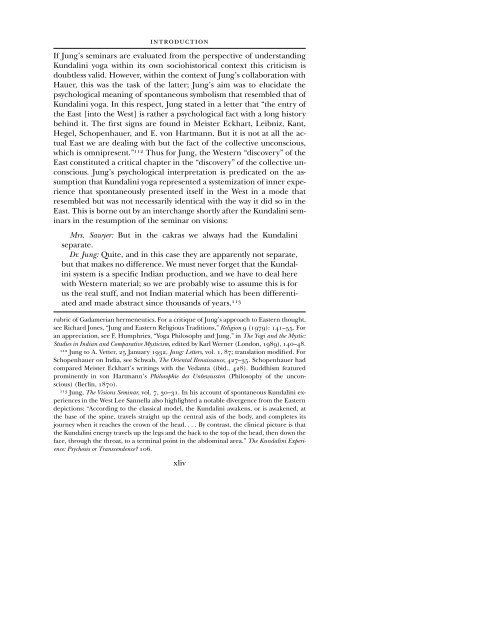CG JUNG - Countryside Anarchist
CG JUNG - Countryside Anarchist
CG JUNG - Countryside Anarchist
Create successful ePaper yourself
Turn your PDF publications into a flip-book with our unique Google optimized e-Paper software.
INTRODUCTION<br />
If Jung’s seminars are evaluated from the perspective of understanding<br />
Kundalini yoga within its own sociohistorical context this criticism is<br />
doubtless valid. However, within the context of Jung’s collaboration with<br />
Hauer, this was the task of the latter; Jung’s aim was to elucidate the<br />
psychological meaning of spontaneous symbolism that resembled that of<br />
Kundalini yoga. In this respect, Jung stated in a letter that “the entry of<br />
the East [into the West] is rather a psychological fact with a long history<br />
behind it. The first signs are found in Meister Eckhart, Leibniz, Kant,<br />
Hegel, Schopenhauer, and E. von Hartmann. But it is not at all the actual<br />
East we are dealing with but the fact of the collective unconscious,<br />
which is omnipresent.” 112 Thus for Jung, the Western “discovery” of the<br />
East constituted a critical chapter in the “discovery” of the collective unconscious.<br />
Jung’s psychological interpretation is predicated on the assumption<br />
that Kundalini yoga represented a systemization of inner experience<br />
that spontaneously presented itself in the West in a mode that<br />
resembled but was not necessarily identical with the way it did so in the<br />
East. This is borne out by an interchange shortly after the Kundalini seminars<br />
in the resumption of the seminar on visions:<br />
Mrs. Sawyer: But in the cakras we always had the Kundalini<br />
separate.<br />
Dr. Jung: Quite, and in this case they are apparently not separate,<br />
but that makes no difference. We must never forget that the Kundalini<br />
system is a specific Indian production, and we have to deal here<br />
with Western material; so we are probably wise to assume this is for<br />
us the real stuff, and not Indian material which has been differentiated<br />
and made abstract since thousands of years. 113<br />
rubric of Gadamerian hermeneutics. For a critique of Jung’s approach to Eastern thought,<br />
see Richard Jones, “Jung and Eastern Religious Traditions,” Religion 9 (1979): 141–55. For<br />
an appreciation, see F. Humphries, “Yoga Philosophy and Jung,” in The Yogi and the Mystic:<br />
Studies in Indian and Comparative Mysticism, edited by Karl Werner (London, 1989), 140–48.<br />
112 Jung to A. Vetter, 25 January 1932, Jung: Letters, vol. 1, 87; translation modified. For<br />
Schopenhauer on India, see Schwab, The Oriental Renaissance, 427–35. Schopenhauer had<br />
compared Meister Eckhart’s writings with the Vedanta (ibid., 428). Buddhism featured<br />
prominently in von Hartmann’s Philosophie des Unbewussten (Philosophy of the unconscious)<br />
(Berlin, 1870).<br />
113 Jung, The Visions Seminar, vol. 7, 30–31. In his account of spontaneous Kundalini experiences<br />
in the West Lee Sannella also highlighted a notable divergence from the Eastern<br />
depictions: “According to the classical model, the Kundalini awakens, or is awakened, at<br />
the base of the spine, travels straight up the central axis of the body, and completes its<br />
journey when it reaches the crown of the head. . . . By contrast, the clinical picture is that<br />
the Kundalini energy travels up the legs and the back to the top of the head, then down the<br />
face, through the throat, to a terminal point in the abdominal area.” The Kundalini Experience:<br />
Psychosis or Transcendence? 106.<br />
xliv


